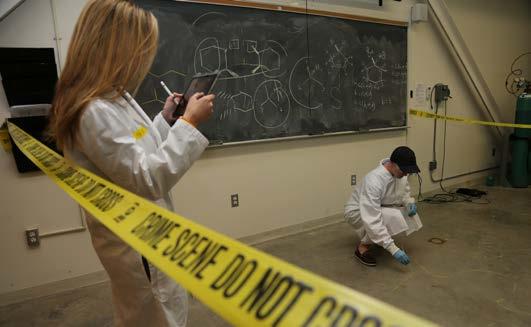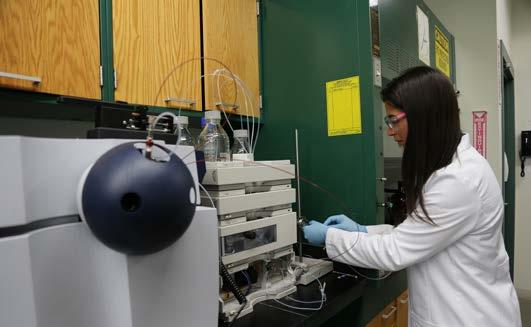
5 minute read
A CSI-Themed Chemistry Laboratory Experiment for First-Year Students
from E-Source for College Transitions | Vol. 17, No. 2
by National Resource Center for The First-Year Experience and Students in Transition
Lauri Gibbons, Adjunct Professor, Merrimack College
Brian Provencher, Assistant Professor, Merrimack College
Advertisement
Jimmy Franco, Associate Professor, Merrimack College
Quezia Lacerda, Andrea Rego & Meghan Martin; Seniors, Merrimack College
The first semester of college can be one of the most important for students, and many initiatives geared toward engaging and retaining students during the first year have been developed (Gilmer, 2007; Watkins & Mazur, 2013). First-year seminars have become a common fixture at most colleges and universities (Allen, 2006; Padgett et al., 2013), and these courses generally focus on helping students with the transition from high school to college, both academically and personally. At Merrimack College in Massachusetts, professionals in the chemistry and biochemistry departments introduced a themed first-year seminar for undecided science majors. Using an activity in the style of CSI: Crime Scene Investigation, the goal was to introduce students to scientific techniques in an effort to simulate their interest in STEM.
Course Design
While Merrimack College has offered a first-year experience (FYE) course to support students during their critical first semester of matriculation and to help them explore their college community, themed FYE courses were recently piloted across all schools at Merrimack in response to the faculty’s request to integrate more academic content into the FYE curriculum using topics the instructors are passionate about. The themed courses are offered for one credit. The goal is to have all FYE courses themed and credit-bearing, with students earning a letter grade for the class.
FYE course instructors must have at least a master’s degree and be a full-time employee. In addition to the instructor, each FYE section has a student peer mentor. Instructors interested in teaching a themed FYE course were asked to submit a proposal with a course description. Each of the themed courses must have the core learning objectives identified by the FYE advisory board but will typically contain several additional learning objectives unique to the course section. Only a few themed courses have been developed, such as photography, athletic training, and a career exploration course for undecided majors.
Every Merrimack student with fewer than 28 credits is automatically enrolled in an FYE course. Students are pre-populated into specific sections based on a number of factors that include major, academic preparedness, career interests, and scheduling constraints. The CSI-themed course is an example of how STEM experiential learning can be integrated into an FYE course. It enables first-year students to dive deeply into an active and hands-on learning experience early in their academic career. Students also develop college-level skills in research, writing, and speaking about their experiential learning experience. Incorporating this kind of theme-based experiential learning fostered greater student engagement in Merrimack’s FYE courses. The course enrolled 18 first-semester students, the majority of whom were undecided science majors. About half of the class was concurrently enrolled in general chemistry.
Crime Scene Activity
Students were presented with a mock crime scene and asked to examine evidence from the scene and suspects. Specifically, students analyzed a residue found at the crime scene and a substance found on each of the suspects’ shoes. Students were tasked with using this information to identify the murderer.
The activity was completed in one 75-minute class. Before entering the laboratory, students completed a pre-lab assignment, which was to research the molecular weight and structure of all the possible compounds presented during the exercise. Inside the lab, students moved between four stations—infrared spectrometry, liquid chromatography, mass spectrometry, and thin layer chromatography—to identify the substances and subsequently identify the murderer. The majority of the students had no prior experience with these processes. For this reason, an instructor or student mentor was positioned at each station to help guide the students through the experiment. They would briefly explain the chemical concept associated with the instrument or analysis technique. Two additional chemistry majors were recruited to help with the stations, which created an opportunity for students to connect with other students in the major. The various stations offered students an opportunity to discover and analyze evidence collected at the mock crime scene. The students then created a poster to present their findings. The FYE students were graded on their poster presentation and not necessarily on correctly identifying the murderer.
Results and Discussion
Overall, the students’ responses to the lab activity were positive. Even students with a modest understanding of the concepts still found the experiment very insightful and engaging. Of the students surveyed, 71.4% indicated the exercise increased their interest in science. The majority of students (64.3%) reported that using the lab instrumentation increased their interest in chemistry. A majority of students also noted they appreciated being able to see the application of chemistry techniques.
The goal of this exercise was to stimulate students’ interest in chemistry and give them a preview of advanced chemical techniques. Students often have difficulties appreciating the material in general chemistry because many of the topics are not immediately applicable to them. One of the benefits of the exercise was exposing students to a situation that would enable them to use fundamental concepts from an introductory science class to solve a real-world problem.

In the laboratory, students moved between four stations using different scientific techniques to identify substances that could potentially determine the murderer.
Photos by Mary Schwalm
Conclusion
This chemistry laboratory activity gave first-year students a hands-on experience with advanced instrumentation and an opportunity for critical thinking. Allowing these undecided science students to use chemical techniques to solve a crime helped generate more engagement in the course and fostered a greater interest in STEM fields, overall. While some of the techniques used are typically introduced in an upper-level course, the students were able to complete all of the experiments in one lab session, and the overall response to the experiment was positive. Additionally, the work illustrates that first-semester students are capable of conducting high-level experiments without extensive background on a particular topic, thus opening up myriad experiential learning opportunities for first-year students. This concept is not limited to chemistry. We hope Merrimack’s experience with themed FYE courses will encourage other institutions to develop their own themed courses to promote greater student engagement.
Acknowledgments
The writers would like to thank the department of chemistry and biochemistry for their support. They would also like to thank the FYE program for their help and support.
References
Allen, M. J. (2006). Assessing general education programs. Jossey-Bass.
Gilmer, T. C. (2007). An understanding of the improved grades, retention and graduation rates of STEM majors at the Academic Investment in Math and Science (AIMS) Program of Bowling Green State University (BGSU). Journal of STEM Education: Innovations and Research, 8(1/2), 11.
Padgett, R. D., Keup, J. R., & Pascarella, E. T. (2013). The impact of first-year seminars on college students’ life-long learning orientations. Journal of Student Affairs Research and Practice, 50(2), 133-151. doi:10.1515/jsarp-2013-0011
Watkins, J., & Mazur, E. (2013). Retaining students in science, technology, engineering, and mathematics (STEM) majors. Journal of College Science Teaching, 42(5), 36-41.




